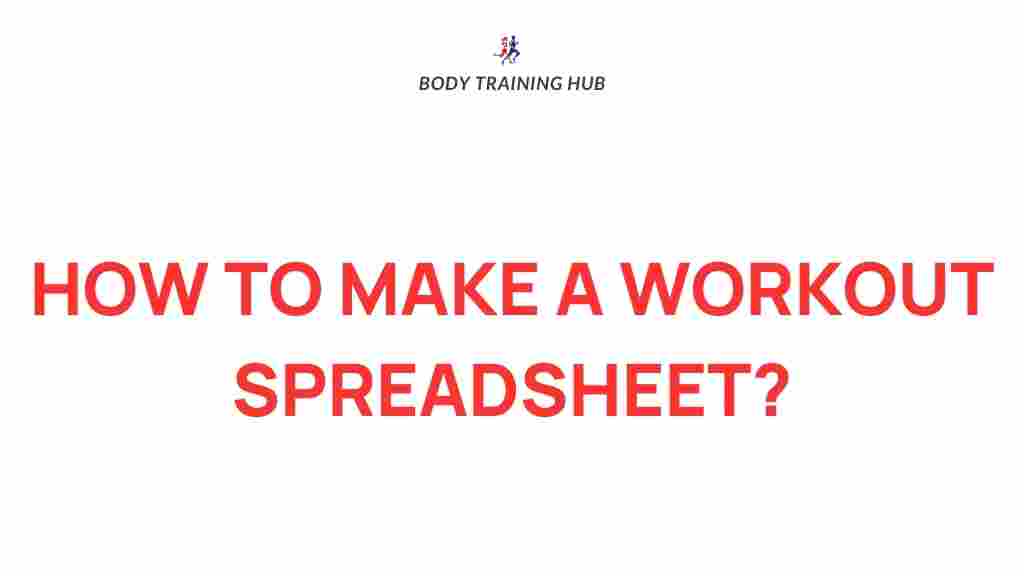Unleash Your Fitness Potential with a Personalized Workout Spreadsheet
Are you struggling to maintain your fitness routine? Do you find it challenging to keep track of your progress and goals? If so, a personalized workout spreadsheet might be the solution you’ve been looking for. In this article, we will explore how a well-organized workout spreadsheet can enhance your fitness journey, help you stay focused, and ultimately unleash your fitness potential.
Why Use a Workout Spreadsheet?
A workout spreadsheet offers numerous benefits that can transform the way you approach fitness. Here are some key reasons to consider using one:
- Organization: A spreadsheet allows you to organize your workouts in a clear and systematic way.
- Tracking Progress: You can easily log your exercises, sets, reps, and weights to monitor your improvements over time.
- Goal Setting: With a spreadsheet, you can set specific fitness goals and track your progress towards achieving them.
- Customization: Personalize your workout routine to suit your individual fitness level and preferences.
Creating Your Personalized Workout Spreadsheet
Now that you understand the benefits, let’s dive into the step-by-step process of creating your personalized workout spreadsheet.
Step 1: Choose Your Platform
The first step is to select a platform for your workout spreadsheet. You can use applications like Microsoft Excel, Google Sheets, or any other spreadsheet software that suits your needs. Google Sheets is a great option because it is accessible from anywhere and allows for easy sharing.
Step 2: Set Up Your Spreadsheet
Open a new spreadsheet and create the following columns:
- Date: Record the date of your workout.
- Exercise: Specify the exercises you will be performing.
- Sets: Indicate the number of sets you plan to complete.
- Reps: Note the number of repetitions for each set.
- Weight: Track the weight you use for each exercise.
- Duration: For cardio workouts, record the duration of the exercise.
- Notes: Include any additional notes about your workout, such as how you felt or modifications made.
Step 3: Define Your Fitness Goals
Before you start filling in your spreadsheet, define your fitness goals. Whether you want to build strength, increase endurance, or lose weight, having clear goals will help guide your workouts. Write down your goals in a separate section of your spreadsheet for easy reference.
Step 4: Plan Your Routine
Design a workout routine that aligns with your fitness goals. Consider the following:
- Frequency: Determine how many days a week you will work out.
- Variety: Include different types of exercises (strength training, cardio, flexibility) to prevent boredom.
- Progression: Plan to gradually increase your weights, sets, or reps over time to continuously challenge yourself.
Step 5: Fill in Your Workouts
Start populating your spreadsheet with your planned workouts. Make sure to fill in the details as you complete each workout. This will help you track your progress effectively.
Step 6: Review and Adjust Regularly
At the end of each week or month, review your progress. Look at your logged workouts and assess whether you’re meeting your goals. Don’t hesitate to adjust your routine based on what you observe. It’s all about finding what works best for you.
Troubleshooting Tips for Your Workout Spreadsheet
Creating and maintaining a workout spreadsheet can sometimes come with challenges. Here are some troubleshooting tips to keep you on track:
1. Feeling Overwhelmed?
If the spreadsheet feels too complex, simplify it. You don’t need to track every detail. Focus on the most important aspects that matter to you.
2. Forgetting to Log Workouts?
Set reminders on your phone or calendar to prompt you to fill in your spreadsheet after each workout. Consistency is key for effective tracking.
3. Struggling with Goal Setting?
If you’re unsure about setting realistic goals, consider consulting with a fitness professional who can help you design a plan that suits your needs. You can also find helpful resources online, such as fitness blogs that offer guidance on goal setting.
4. Not Seeing Progress?
Sometimes progress can be slow. Ensure you are challenging yourself appropriately and maintaining a balanced diet. If needed, tweak your workout routine or seek advice from fitness forums or communities.
Conclusion
A personalized workout spreadsheet is an invaluable tool for anyone looking to enhance their fitness journey. By organizing your workouts, tracking your progress, and keeping your goals in sight, you can create a routine that propels you towards success. Remember, the journey to fitness is unique for everyone, so be patient with yourself and celebrate small victories along the way. Ready to take your fitness to the next level? Start crafting your personalized workout spreadsheet today and unleash your full potential!
For more insights on improving your fitness routine, check out our other articles here.
This article is in the category Training Guides and created by BodyTraining Team
